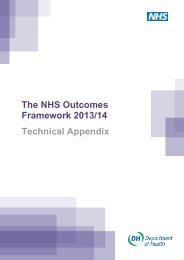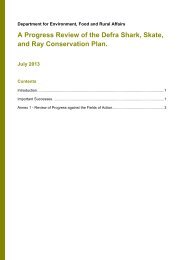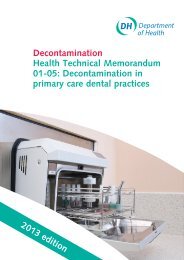A study of Patent Thickets (1.31Mb) - UK Intellectual Property Office
A study of Patent Thickets (1.31Mb) - UK Intellectual Property Office
A study of Patent Thickets (1.31Mb) - UK Intellectual Property Office
Create successful ePaper yourself
Turn your PDF publications into a flip-book with our unique Google optimized e-Paper software.
54 A Study <strong>of</strong> <strong>Patent</strong> <strong>Thickets</strong><br />
The list is shown in Table 4.2, along with the number <strong>of</strong> EPO and <strong>UK</strong>IPO patents applied for by<br />
<strong>UK</strong> firms in the Fame database with priority dates between 2002 and 2009. A comparison <strong>of</strong> the<br />
frequency distribution across the technology classes in the two patent <strong>of</strong>fices clearly shows that<br />
firms prefer to apply for chemical patents at the EPO whereas in other technologies they slightly<br />
prefer to apply at the <strong>UK</strong>IPO.<br />
A complication is that each firm can enter into any one <strong>of</strong> the 34 technology sectors, and many<br />
<strong>of</strong> the firms enter more than one, as one might have expected. More than half the firms patent<br />
in more than one sector, and 10 per cent patent in more than four. Our solution to this problem<br />
is to treat each entry possibility separately for each firm. That is, we have about 29,000 firms,<br />
each <strong>of</strong> which can potentially enter into each one <strong>of</strong> the 34 technology sectors, yielding about<br />
one million observations at risk. We cluster the standard errors by firm, so the model is effectively<br />
a firm random effects model for entry into the 34 sectors.<br />
In order to isolate the possible impact <strong>of</strong> triples on entry into patenting, it is important to control<br />
for other characteristics that affect the probability that a firm chooses to patent in a particular<br />
technology sector. First, it is well known that firm size and industry are important predictors <strong>of</strong><br />
whether a firm patents at all (Bound et al. 1984 for US data). Hall et al. (2012) show this for <strong>UK</strong><br />
patenting during the period studied here. In our entry regressions, we include the logarithm <strong>of</strong><br />
the firm’s reported assets and a set <strong>of</strong> two-digit industry dummies to control for these<br />
characteristics. 34 Second, we would expect that technology sectors with many triples are also<br />
sectors with many patents, and it is therefore more likely that a firm will patent in that sector,<br />
other things equal. To control for this effect, we include the logarithm <strong>of</strong> the aggregate EP patent<br />
applications in the technology sector during the year, and we normalize the count <strong>of</strong> triples by<br />
aggregate patenting in the same sector, so that the triples variable represents the intensity with<br />
which firms potentially hold blocking patents on each other relative to aggregate patenting<br />
activity in the technology.<br />
In the appendices, we describe in some detail the hazard models that we estimate (Section 7.3)<br />
and we show a number <strong>of</strong> exploratory regressions made using various models and specifications<br />
in the appendix tables 7.3 and 7.4. None <strong>of</strong> the choices made substantive differences to the<br />
effects <strong>of</strong> interest and in this part <strong>of</strong> the report we focus on the results from our preferred<br />
specification, the log-logistic accelerated failure time model, estimated with stratification by<br />
two-digit industry. The effect <strong>of</strong> the stratification is that we allow firms in each <strong>of</strong> the industries<br />
to have different means and standard deviations <strong>of</strong> the time until entry into patenting. That is,<br />
each industry has its own “failure” time distribution, where failure is defined as entry into patenting<br />
in a technology area, but this distribution is also modified by the firm’s size, aggregate patenting<br />
in the technology, and the triples density.<br />
Our estimation sample has about 29 thousand firms and one million firm-TF34 sector<br />
combinations. During the 2002-2009 period there are 12,991 entries into patenting for the first<br />
time in a technology sector by these firms. Table 7.1 shows the distribution <strong>of</strong> the number <strong>of</strong><br />
entries per firm: 3,507 enter one class, and the remainder enter more than one. Table 7.2 shows<br />
the FAME population <strong>of</strong> <strong>UK</strong> firms in our industries, together with the shares in each industry that<br />
have applied for a <strong>UK</strong> or EP patent during the 2001-2009 period. These shares range from over<br />
34 The choice <strong>of</strong> assets as a size measure reflects the fact that it is the only size variable available for the majority <strong>of</strong><br />
the firms in the FAME dataset.

















